Side-Chain Modified [99mTc]Tc-DT1 Mimics: A Comparative Study in NTS1R-Positive Models
Abstract
:1. Introduction
2. Results
2.1. Ligands and Radioligands
2.2. In Vitro Studies
2.2.1. Binding Affinities for the Human NTS1R
2.2.2. Radioligand Internalization in AsPC-1 Cells
2.2.3. Radioligand Binding to Albumin
2.3. Animal Experiments
2.3.1. Radioligand Stability in Mice
2.3.2. Radioligand Biodistribution in AsPC-1 Tumor-Bearing Mice
2.3.3. SPECT/CT in AsPC-1 Tumor-Bearing Mice
3. Discussion
4. Materials and Methods
4.1. Chemicals and Radioligands
4.1.1. Chemicals and Radionuclides
4.1.2. Radioligands—Radiochemistry
4.2. Cell Studies
4.2.1. Cell Lines—Cell Culture
4.2.2. Competition Binding Assays
4.2.3. Cell Internalization Experiments
4.2.4. Albumin Binding Assays
4.3. Animal Studies
4.3.1. Healthy and Tumor-Bearing Immunosuppressed Mice
4.3.2. Metabolic Studies in Healthy Mice
4.3.3. Biodistribution in Tumor-Bearing SCID Mice
4.3.4. SPECT/CT Imaging of Tumor-Bearing SCID Mice
5. Conclusions
Supplementary Materials
Author Contributions
Funding
Institutional Review Board Statement
Informed Consent Statement
Data Availability Statement
Conflicts of Interest
References
- Kitabgi, P. Targeting neurotensin receptors with agonists and antagonists for therapeutic purposes. Curr. Opin. Drug Discov. Devel. 2002, 5, 764–776. [Google Scholar] [PubMed]
- Nikolaou, S.; Qiu, S.; Fiorentino, F.; Simillis, C.; Rasheed, S.; Tekkis, P.; Kontovounisios, C. The role of neurotensin and its receptors in non-gastrointestinal cancers: A review. Cell Commun. Signal. 2020, 18, 68. [Google Scholar] [CrossRef]
- Reubi, J.C.; Waser, B.; Friess, H.; Büchler, M.; Laissue, J. Neurotensin receptors: A new marker for human ductal pancreatic adenocarcinoma. Gut 1998, 42, 546–550. [Google Scholar] [CrossRef] [PubMed]
- Körner, M.; Waser, B.; Strobel, O.; Büchler, M.; Reubi, J.C. Neurotensin receptors in pancreatic ductal carcinomas. EJNMMI Res. 2015, 5, 17. [Google Scholar] [CrossRef] [PubMed]
- Ishizuka, J.; Townsend, C.M., Jr.; Thompson, J.C. Neurotensin regulates growth of human pancreatic cancer. Ann. Surg. 1993, 217, 439–445, discussion 446. [Google Scholar] [CrossRef] [PubMed]
- Gui, X.; Guzman, G.; Dobner, P.R.; Kadkol, S.S. Increased neurotensin receptor-1 expression during progression of colonic adenocarcinoma. Peptides 2008, 29, 1609–1615. [Google Scholar] [CrossRef]
- Reubi, J.C.; Waser, B.; Schaer, J.C.; Laissue, J.A. Neurotensin receptors in human neoplasms: High incidence in Ewing’s sarcomas. Int. J. Cancer 1999, 82, 213–218. [Google Scholar] [CrossRef]
- Morgat, C.; Chastel, A.; Molinie, V.; Schollhammer, R.; Macgrogan, G.; Velasco, V.; Malavaud, B.; Fernandez, P.; Hindie, E. Neurotensin receptor-1 expression in human prostate cancer: A pilot study on primary tumors and lymph node metastases. Int. J. Mol. Sci. 2019, 20, 1721. [Google Scholar] [CrossRef]
- Souaze, F.; Dupouy, S.; Viardot-Foucault, V.; Bruyneel, E.; Attoub, S.; Gespach, C.; Gompel, A.; Forgez, P. Expression of neurotensin and NT1 receptor in human breast cancer: A potential role in tumor progression. Cancer Res. 2006, 66, 6243–6249. [Google Scholar] [CrossRef]
- Achilefu, S.; Srinivasan, A.; Schmidt, M.A.; Jimenez, H.N.; Bugaj, J.E.; Erion, J.L. Novel bioactive and stable neurotensin peptide analogues capable of delivering radiopharmaceuticals and molecular beacons to tumors. J. Med. Chem. 2003, 46, 3403–3411. [Google Scholar] [CrossRef]
- Maschauer, S.; Prante, O. Radiopharmaceuticals for imaging and endoradiotherapy of neurotensin receptor-positive tumors. J. Labelled Comp. Radiopharm. 2018, 61, 309–325. [Google Scholar] [CrossRef] [PubMed]
- Cornelissen, B.; Knight, J.C.; Mukherjee, S.; Evangelista, L.; Xavier, C.; Caobelli, F.; Del Vecchio, S.; Rbah-Vidal, L.; Barbet, J.; de Jong, M.; et al. Translational molecular imaging in exocrine pancreatic cancer. Eur. J. Nucl. Med. Mol. Imaging 2018, 45, 2442–2455. [Google Scholar] [CrossRef] [PubMed]
- Leonte, R.A.; Chilug, L.E.; Șerban, R.; Mustăciosu, C.; Raicu, A.; Manda, G.; Niculae, D. Preparation and preliminary evaluation of neurotensin radiolabelled with 68Ga and 177Lu as potential theranostic agent for colon cancer. Pharmaceutics 2021, 13, 506. [Google Scholar] [CrossRef] [PubMed]
- Mascarin, A.; Valverde, I.E.; Mindt, T.L. Structure-activity relationship studies of amino acid substitutions in radiolabeled neurotensin conjugates. ChemMedChem 2016, 11, 102–107. [Google Scholar] [CrossRef]
- Schindler, L.; Moosbauer, J.; Schmidt, D.; Spruss, T.; Grätz, L.; Lüdeke, S.; Hofheinz, F.; Meister, S.; Echtenacher, B.; Bernhardt, G.; et al. Development of a neurotensin-derived 68Ga-labeled PET ligand with high in vivo stability for imaging of NTS1 receptor-expressing tumors. Cancers 2022, 14, 4922. [Google Scholar] [CrossRef]
- Schubiger, P.A.; Allemann-Tannahill, L.; Egli, A.; Schibli, R.; Alberto, R.; Carrel-Remy, N.; Willmann, M.; Blauenstein, P.; Tourwé, D. Catabolism of neurotensins. Implications for the design of radiolabeling strategies of peptides. Q. J. Nucl. Med. 1999, 43, 155–158. [Google Scholar]
- Nock, B.A.; Nikolopoulou, A.; Reubi, J.C.; Maes, V.; Conrath, P.; Tourwé, D.; Maina, T. Toward stable N4-modified neurotensins for NTS1-receptor-targeted tumor imaging with 99mTc. J. Med. Chem. 2006, 49, 4767–4776. [Google Scholar] [CrossRef]
- Maina, T.; Nikolopoulou, A.; Stathopoulou, E.; Galanis, A.S.; Cordopatis, P.; Nock, B.A. [99mTc]Demotensin 5 and 6 in the NTS1-R-targeted imaging of tumours: Synthesis and preclinical results. Eur. J. Nucl. Med. Mol. Imaging 2007, 34, 1804–1814. [Google Scholar] [CrossRef]
- Buchegger, F.; Bonvin, F.; Kosinski, M.; Schaffland, A.O.; Prior, J.; Reubi, J.C.; Blauenstein, P.; Tourwé, D.; Garcia Garayoa, E.; Bischof Delaloye, A. Radiolabeled neurotensin analog, 99mTc-NT-XI, evaluated in ductal pancreatic adenocarcinoma patients. J. Nucl. Med. 2003, 44, 1649–1654. [Google Scholar]
- Gabriel, M.; Decristoforo, C.; Woll, E.; Eisterer, W.; Nock, B.; Maina, T.; Moncayo, R.; Virgolini, I. [99mTc]Demotensin VI: Biodistribution and initial clinical results in tumor patients of a pilot/phase I study. Cancer Biother. Radiopharm. 2011, 26, 557–563. [Google Scholar] [CrossRef]
- Fröberg, A.C.; van Eijck, C.; Verdijsseldonck, M.C.; Melis, M.; Bakker, H.; Krenning, E.P. Use of neurotensin analogue In-111-DTPA-neurotensin (In-111-MP2530) in diagnosis of pancreatic adenocarcinoma. Eur. J. Nucl. Med. Mol. Imaging 2004, 31 (Suppl. S2), S392. [Google Scholar]
- Kitabgi, P.; De Nadai, F.; Rovere, C.; Bidard, J.N. Biosynthesis, maturation, release, and degradation of neurotensin and neuromedin N. Ann. N. Y. Acad. Sci. 1992, 668, 30–42. [Google Scholar] [CrossRef] [PubMed]
- Kitabgi, P.; Dubuc, I.; Nouel, D.; Costentin, J.; Cuber, J.C.; Fulcrand, H.; Doulut, S.; Rodriguez, M.; Martinez, J. Effects of thiorphan, bestatin and a novel metallopeptidase inhibitor JMV 390-1 on the recovery of neurotensin and neuromedin N released from mouse hypothalamus. Neurosci. Lett. 1992, 142, 200–204. [Google Scholar] [CrossRef] [PubMed]
- Checler, F.; Vincent, J.P.; Kitabgi, P. Degradation of neurotensin by rat brain synaptic membranes: Involvement of a thermolysin-like metalloendopeptidase (enkephalinase), angiotensin-converting enzyme, and other unidentified peptidases. J. Neurochem. 1983, 41, 375–384. [Google Scholar] [CrossRef]
- Skidgel, R.A.; Engelbrecht, S.; Johnson, A.R.; Erdös, E.G. Hydrolysis of substance P and neurotensin by converting enzyme and neutral endopeptidase. Peptides 1984, 5, 769–776. [Google Scholar] [CrossRef]
- Kanellopoulos, P.; Kaloudi, A.; Jong, M.; Krenning, E.P.; Nock, B.A.; Maina, T. Key-protease inhibition regimens promote tumor targeting of neurotensin radioligands. Pharmaceutics 2020, 12, 528. [Google Scholar] [CrossRef]
- Kanellopoulos, P.; Nock, B.A.; Krenning, E.P.; Maina, T. Optimizing the profile of [99mTc]Tc-NT(7-13) tracers in pancreatic cancer models by means of protease inhibitors. Int. J. Mol. Sci. 2020, 21, 7926. [Google Scholar] [CrossRef]
- Rohrbach, M.S.; Williams, E.B., Jr.; Rolstad, R.A. Purification and substrate specificity of bovine angiotensin-converting enzyme. J. Biol. Chem. 1981, 256, 225–230. [Google Scholar] [CrossRef]
- Armayor, G.M.; Lopez, L.M. Lisinopril: A new angiotensin-converting enzyme inhibitor. Drug. Intell. Clin. Pharm. 1988, 22, 365–372. [Google Scholar] [CrossRef]
- Salazar-Lindo, E.; Santisteban-Ponce, J.; Chea-Woo, E.; Gutierrez, M. Racecadotril in the treatment of acute watery diarrhea in children. N. Engl. J. Med. 2000, 343, 463–467. [Google Scholar] [CrossRef]
- Roques, B.P.; Noble, F.; Dauge, V.; Fournie-Zaluski, M.C.; Beaumont, A. Neutral endopeptidase 24.11: Structure, inhibition, and experimental and clinical pharmacology. Pharmacol. Rev. 1993, 45, 87–146. [Google Scholar] [PubMed]
- Valkema, R.; Sconebaum, L.E.; Fröberg, A.C.; Maina, T.; Nock, B.A.; de Blois, E.; Konijnenberg, M.W.; Koolen, S.L.W.; Peeters, R.P.; Visser, W.E.; et al. PepProtect: Improved detection of cancer and metastases by peptide scanning under the protection of enzyme inhibitors. Eur. J. Nucl. Med. Mol. Imaging 2022, 49 (Suppl. S1), S81. [Google Scholar] [CrossRef]
- Schiering, N.; D’Arcy, A.; Villard, F.; Ramage, P.; Logel, C.; Cumin, F.; Ksander, G.M.; Wiesmann, C.; Karki, R.G.; Mogi, M. Structure of neprilysin in complex with the active metabolite of sacubitril. Sci. Rep. 2016, 6, 27909. [Google Scholar] [CrossRef]
- Ayalasomayajula, S.; Langenickel, T.; Pal, P.; Boggarapu, S.; Sunkara, G. Clinical pharmacokinetics of sacubitril/valsartan (LCZ696): A novel angiotensin receptor-neprilysin inhibitor. Clin. Pharmacokinet. 2017, 56, 1461–1478. [Google Scholar] [CrossRef] [PubMed]
- Han, Y.; Ayalasomayajula, S.; Pan, W.; Yang, F.; Yuan, Y.; Langenickel, T.; Hinder, M.; Kalluri, S.; Pal, P.; Sunkara, G. Pharmacokinetics, safety and tolerability of sacubitril/valsartan (LCZ696) after single-dose administration in healthy chinese subjects. Eur. J. Drug Metab. Pharmacokinet. 2017, 42, 109–116. [Google Scholar] [CrossRef] [PubMed]
- Kanellopoulos, P.; Nock, B.A.; Krenning, E.P.; Maina, T. Toward stability enhancement of NTS1R-targeted radioligands: Structural interventions on [99mTc]Tc-DT1. Pharmaceutics 2023, 15, 2092. [Google Scholar] [CrossRef] [PubMed]
- Kostelnik, K.B.; Els-Heindl, S.; Kloting, N.; Baumann, S.; von Bergen, M.; Beck-Sickinger, A.G. High metabolic in vivo stability and bioavailability of a palmitoylated ghrelin receptor ligand assessed by mass spectrometry. Bioorg. Med. Chem. 2015, 23, 3925–3932. [Google Scholar] [CrossRef]
- Zhang, L.; Bulaj, G. Converting peptides into drug leads by lipidation. Curr. Med. Chem. 2012, 19, 1602–1618. [Google Scholar] [CrossRef]
- Bellmann-Sickert, K.; Elling, C.E.; Madsen, A.N.; Little, P.B.; Lundgren, K.; Gerlach, L.O.; Bergmann, R.; Holst, B.; Schwartz, T.W.; Beck-Sickinger, A.G. Long-acting lipidated analogue of human pancreatic polypeptide is slowly released into circulation. J. Med. Chem. 2011, 54, 2658–2667. [Google Scholar] [CrossRef]
- Erak, M.; Bellmann-Sickert, K.; Els-Heindl, S.; Beck-Sickinger, A.G. Peptide chemistry toolbox—Transforming natural peptides into peptide therapeutics. Bioorg. Med. Chem. 2018, 26, 2759–2765. [Google Scholar] [CrossRef]
- Craig, A.G.; Norberg, T.; Griffin, D.; Hoeger, C.; Akhtar, M.; Schmidt, K.; Low, W.; Dykert, J.; Richelson, E.; Navarro, V.; et al. Contulakin-G, an O-glycosylated invertebrate neurotensin. J. Biol. Chem. 1999, 274, 13752–13759. [Google Scholar] [CrossRef]
- Green, B.R.; White, K.L.; McDougle, D.R.; Zhang, L.; Klein, B.; Scholl, E.A.; Pruess, T.H.; White, H.S.; Bulaj, G. Introduction of lipidization-cationization motifs affords systemically bioavailable neuropeptide Y and neurotensin analogs with anticonvulsant activities. J. Pept. Sci. 2010, 16, 486–495. [Google Scholar] [CrossRef]
- Lee, H.K.; Zhang, L.; Smith, M.D.; Walewska, A.; Vellore, N.A.; Baron, R.; McIntosh, J.M.; White, H.S.; Olivera, B.M.; Bulaj, G. A marine analgesic peptide, contulakin-G, and neurotensin are distinct agonists for neurotensin receptors: Uncovering structural determinants of desensitization properties. Front. Pharmacol. 2015, 6, 11. [Google Scholar] [CrossRef] [PubMed]
- Dumelin, C.E.; Trussel, S.; Buller, F.; Trachsel, E.; Bootz, F.; Zhang, Y.; Mannocci, L.; Beck, S.C.; Drumea-Mirancea, M.; Seeliger, M.W.; et al. A portable albumin binder from a DNA-encoded chemical library. Angew. Chem. Int. Ed. Engl. 2008, 47, 3196–3201. [Google Scholar] [CrossRef] [PubMed]
- Müller, C.; Struthers, H.; Winiger, C.; Zhernosekov, K.; Schibli, R. DOTA conjugate with an albumin-binding entity enables the first folic acid-targeted 177Lu-radionuclide tumor therapy in mice. J. Nucl. Med. 2013, 54, 124–131. [Google Scholar] [CrossRef] [PubMed]
- Zhang, X.; Wang, H.; Ma, Z.; Wu, B. Effects of pharmaceutical pegylation on drug metabolism and its clinical concerns. Expert Opin. Drug Metab. Toxicol. 2014, 10, 1691–1702. [Google Scholar] [CrossRef] [PubMed]
- Maoret, J.J.; Pospai, D.; Rouyer-Fessard, C.; Couvineau, A.; Laboisse, C.; Voisin, T.; Laburthe, M. Neurotensin receptor and its mRNA are expressed in many human colon cancer cell lines but not in normal colonic epithelium: Binding studies and RT-PCR experiments. Biochem. Biophys. Res. Commun. 1994, 203, 465–471. [Google Scholar] [CrossRef]
- Itoh, T.; Saura, Y.; Tsuda, Y.; Yamada, H. Stereoselectivity and enantiomer-enantiomer interactions in the binding of ibuprofen to human serum albumin. Chirality 1997, 9, 643–649. [Google Scholar] [CrossRef]
- Nock, B.A.; Maina, T.; Krenning, E.P.; de Jong, M. “To serve and protect”: Enzyme inhibitors as radiopeptide escorts promote tumor targeting. J. Nucl. Med. 2014, 55, 121–127. [Google Scholar] [CrossRef]
- Stevens, P.W.; Hansberry, M.R.; Kelso, D.M. Assessment of adsorption and adhesion of proteins to polystyrene microwells by sequential enzyme-linked immunosorbent assay analysis. Anal. Biochem. 1995, 225, 197–205. [Google Scholar] [CrossRef]
- Liu, S.; Bilal, M.; Rizwan, K.; Gul, I.; Rasheed, T.; Iqbal, H.M.N. Smart chemistry of enzyme immobilization using various support matrices—A review. Int. J. Biol. Macromol. 2021, 190, 396–408. [Google Scholar] [CrossRef] [PubMed]
- Vlasova, I.M.; Saletskii, A.M. Fluorescence of tryptophan in the denaturation of human serum albumin under the action of sodium dodecyl sulfate. Russ. J. Phys. Chem. B 2009, 3, 976–980. [Google Scholar] [CrossRef]
- Enlow, E.; Abbaszadeh, S. State-of-the-art challenges and emerging technologies in radiation detection for nuclear medicine imaging: A review. Front. Phys. 2023, 11, 1106546. [Google Scholar] [CrossRef]
- Ozsahin, I.; Chen, L.; Könik, A.; King, M.A.; Beekman, F.J.; Mok, G.S.P. The clinical utilities of multi-pinhole single photon emission computed tomography. Quant. Imaging Med. Surg. 2020, 10, 2006–2029. [Google Scholar] [CrossRef] [PubMed]
- Bal, G.; Acton, P.D. Analytical derivation of the point spread function for pinhole collimators. Phys. Med. Biol. 2006, 51, 4923–4950. [Google Scholar] [CrossRef] [PubMed]
- Desmonts, C.; Bouthiba, M.A.; Enilorac, B.; Nganoa, C.; Agostini, D.; Aide, N. Evaluation of a new multipurpose whole-body CzT-based camera: Comparison with a dual-head Anger camera and first clinical images. EJNMMI Phys. 2020, 7, 18. [Google Scholar] [CrossRef]
- Boschi, A.; Uccelli, L.; Martini, P. A picture of modern Tc-99m radiopharmaceuticals: Production, chemistry, and applications in molecular imaging. Appl. Sci. 2019, 9, 2526. [Google Scholar] [CrossRef]
- Duatti, A. Review on 99mTc radiopharmaceuticals with emphasis on new advancements. Nucl. Med. Biol. 2021, 92, 202–216. [Google Scholar] [CrossRef]
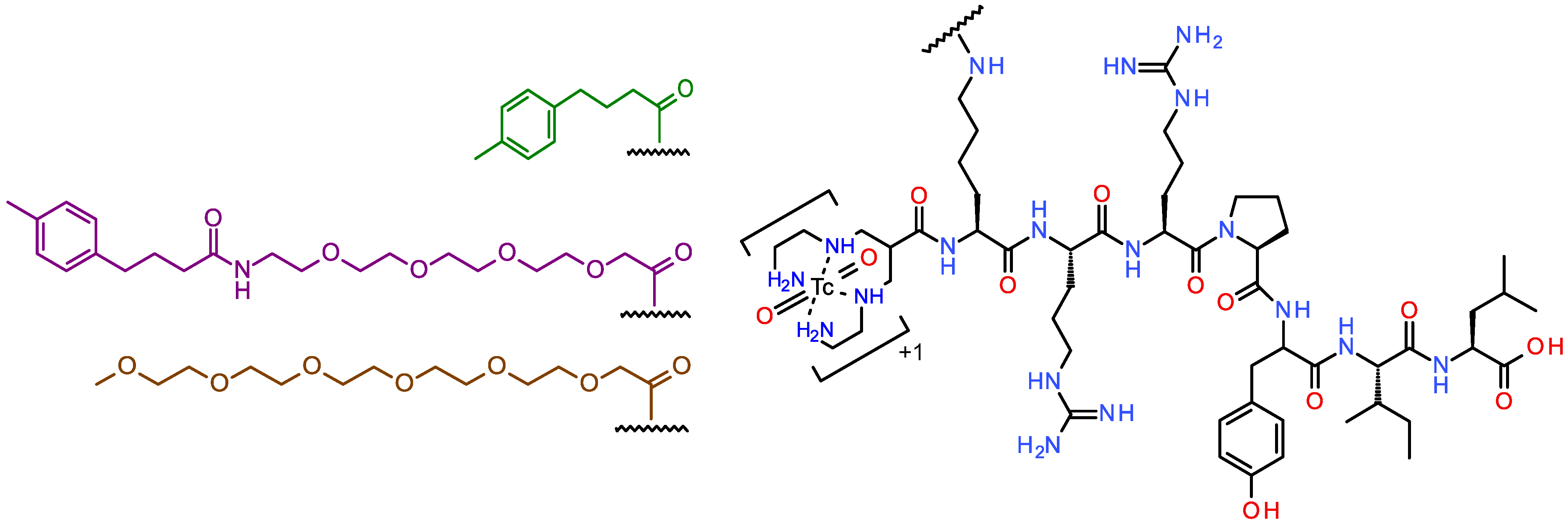

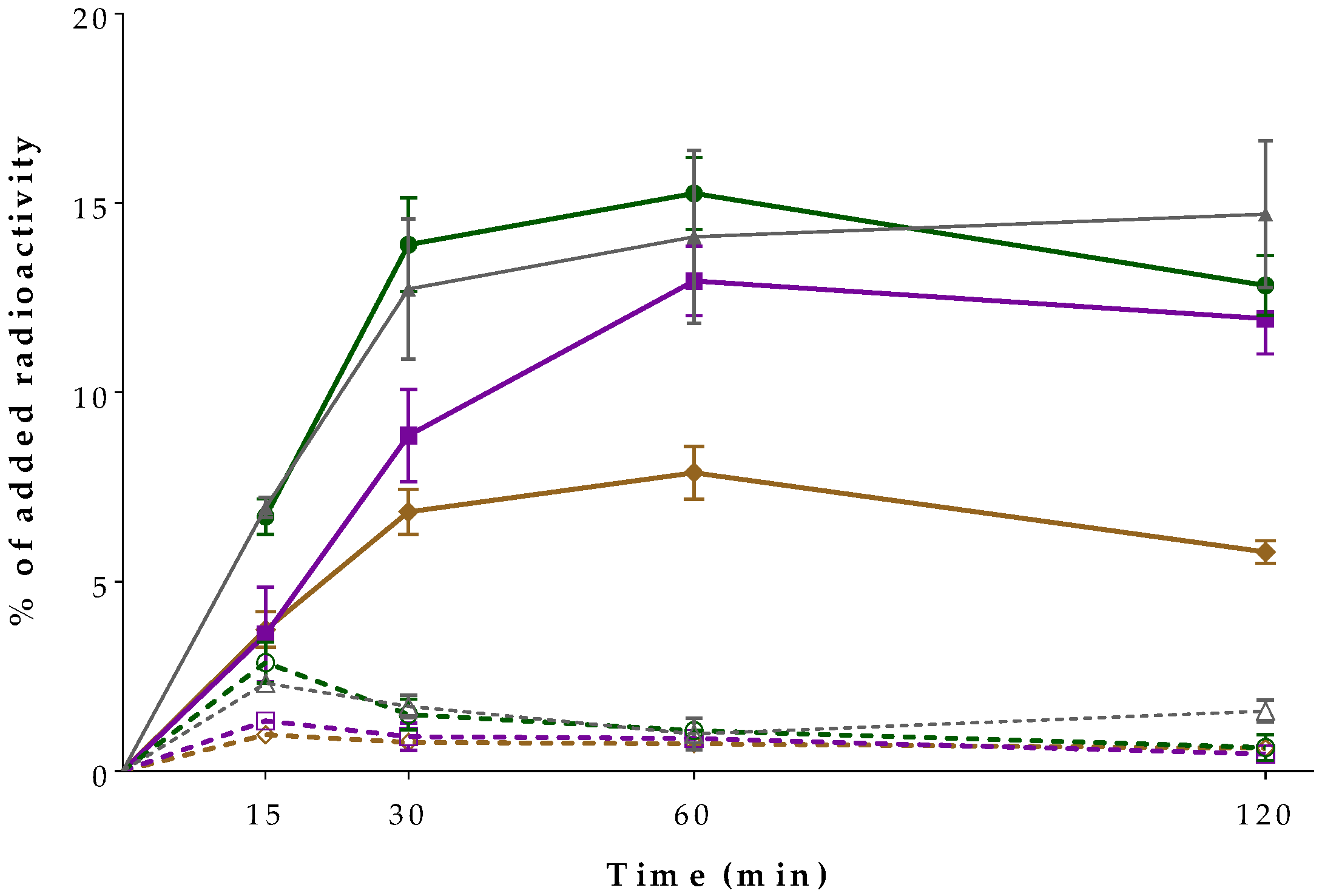

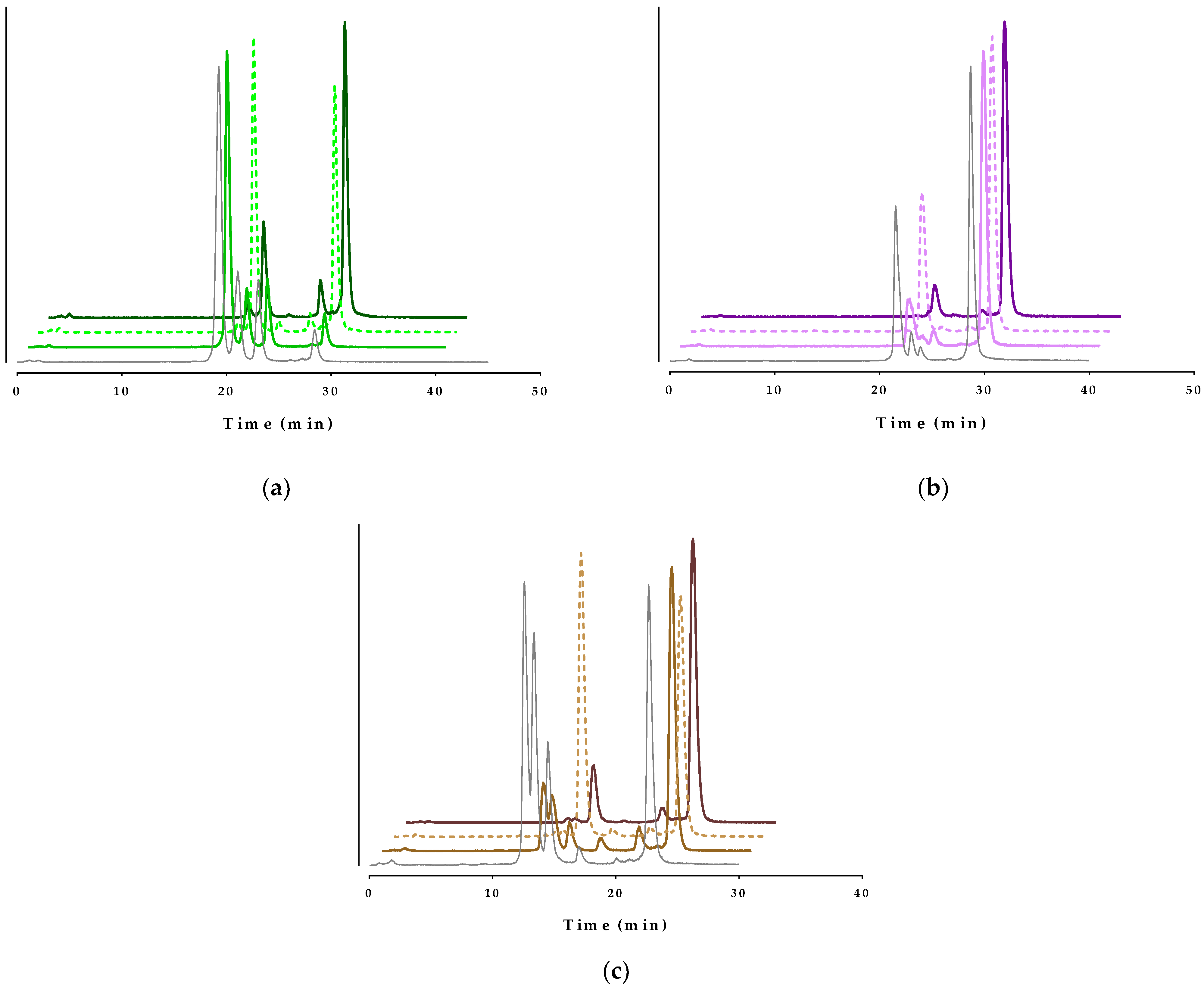
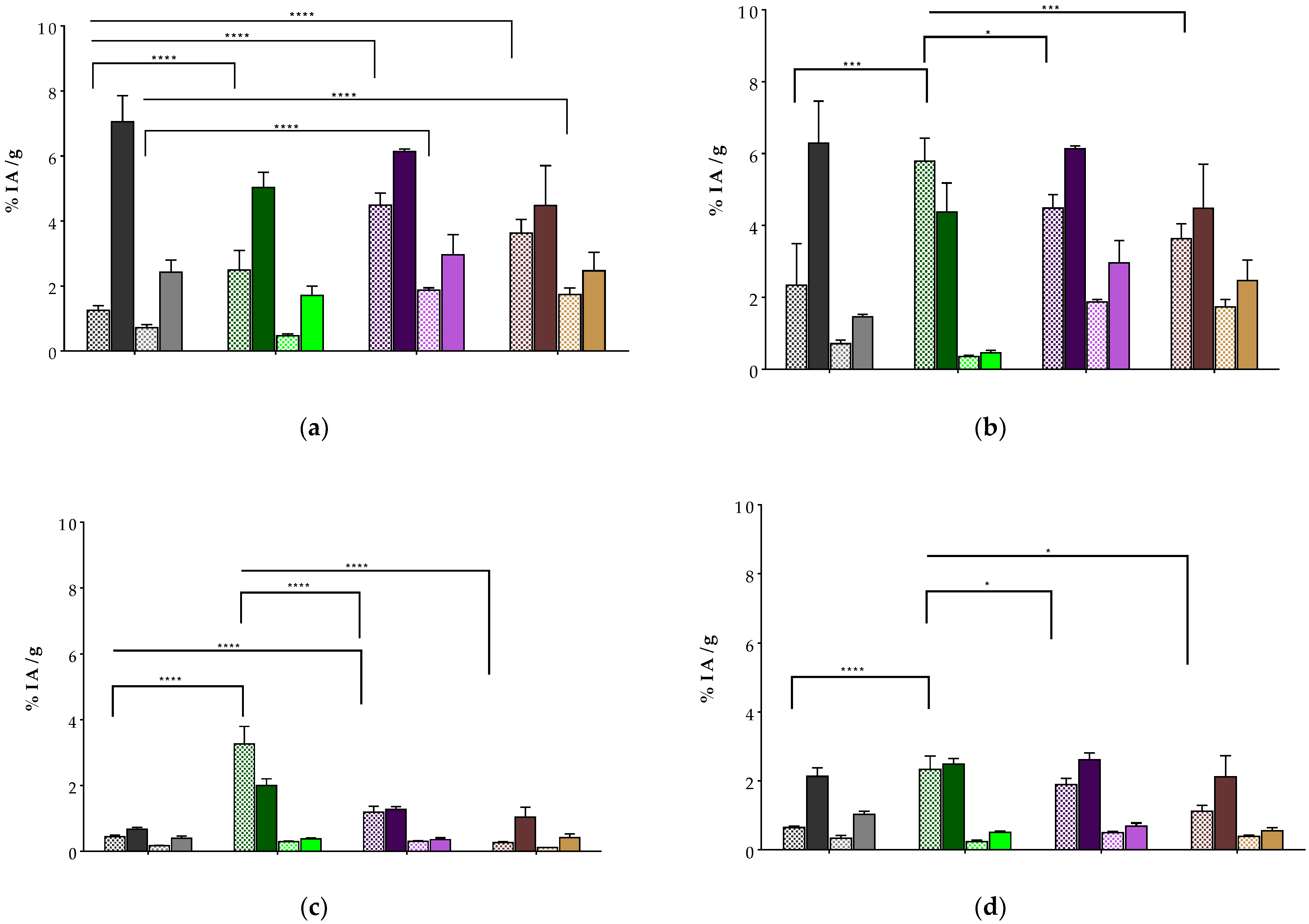
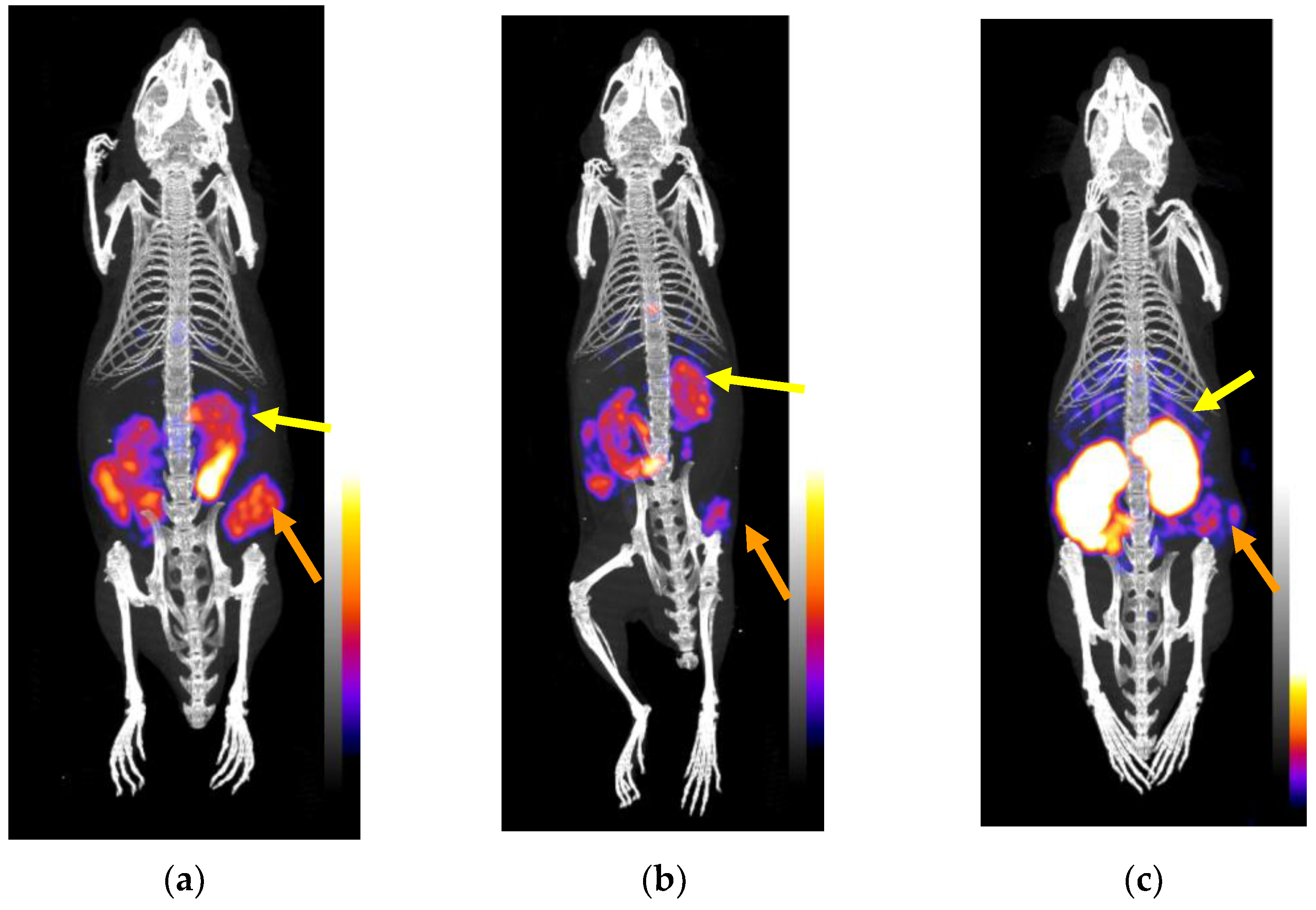
| [99mTc]Tc-DT1 1 | [99mTc]Tc-DT10 | [99mTc]Tc-DT11 | [99mTc]Tc-DT12 | |
|---|---|---|---|---|
| Control | 1.81 ± 0.77 (n = 4) | 5.09 ± 0.89 (3) | 56.56 ± 5.19 (3) | 35.65 ± 5.00 (3) |
| Entresto® | 5.46 ± 3.86 (n = 5) | 5.15 ± 1.58 (3) | 76.98 ± 3.31 (3) | 58.69 ± 7.17 (3) |
| Lis | 18.77 ± 2.54 (n = 3) | 37.14 ±6.49 (3) | 66.89 ± 1.24 (3) | 42.63 ± 2.79 (3) |
| Entresto® + Lis | 63.80 ± 7.51 (n = 3) | 68.02 ± 3.01 (3) | 86.33 ± 1.94 (3) | 73.98 ± 4.93 (3) |
| Organs/Tissues | [99mTc]Tc-DT10 (%IA/g) | ||||
|---|---|---|---|---|---|
| 4 h | 24 h | ||||
| Block | Controls | Entresto® + Lis | Controls | Entresto® + Lis | |
| Blood | 0.82 ± 0.25 | 3.46 ± 0.60 | 1.20 ± 0.26 | 0.04 ± 0.01 | 0.05 ± 0.01 |
| Liver | 1.77 ± 0.21 | 3.27 ± 0.53 | 2.00 ± 0.20 | 0.29 ± 0.02 | 0.38 ± 0.04 |
| Heart | 0.28 ± 0.06 | 1.12 ± 0.31 | 0.43 ±0.07 | 0.04 ± 0.01 | 0.04 ± 0.01 |
| Kidneys | 3.93 ± 1.25 | 5.79 ± 0.63 | 4.38 ± 0.81 | 0.36 ± 0.03 | 0.45 ± 0.07 |
| Stomach | 0.43 ± 0.12 | 1.03 ± 0.29 | 0.90 ± 0.34 | 0.17 ± 0.04 | 0.11 ± 0.03 |
| Intestines | 1.04 ± 0.10 | 2.34 ± 0.39 | 2.49 ± 0.16 | 0.24 ± 0.04 | 0.51 ± 0.04 |
| Spleen | 0.66 ± 0.08 | 0.65 ± 0.11 | 1.10 ± 0.22 | 0.10 ± 0.02 | 0.26 ± 0.03 |
| Muscle | 0.13 ± 0.04 | 0.37 ±0.05 | 0.16 ± 0.04 | 0.01 ± 0.01 | 0.02 ± 0.01 |
| Lungs | 0.84 ± 0.17 | 2.15 ± 0.25 | 1.30 ± 0.48 | 0.16 ± 0.03 | 0.18 ± 0.04 |
| Pancreas | 0.20 ± 0.03 | 0.51 ± 0.11 | 0.30 ± 0.16 | 0.02 ± 0.00 | 0.03 ± 0.01 |
| AsPC-1 Tumor | 1.60 ± 0.67 | 2.49 ± 0.60 | 5.03 ± 0.47 | 0.47 ± 0.06 | 1.71 ± 0.28 |
| Organs/Tissues | [99mTc]Tc-DT11 (%IA/g) | ||||
|---|---|---|---|---|---|
| 4 h | 24 h | ||||
| Block | Controls | Entresto® | Controls | Entresto® | |
| Blood | 0.08 ± 0.29 | 0.99 ± 0.35 | 0.93 ± 0.12 | 0.07 ± 0.01 | 0.08 ± 0.01 |
| Liver | 0.31 ± 0.02 | 1.19 ± 0.18 | 1.27 ± 0.08 | 0.31 ± 0.02 | 0.35 ± 0.05 |
| Heart | 0.04 ± 0.01 | 0.39 ± 0.10 | 0.34 ± 0.06 | 0.04 ± 0.01 | 0.08 ± 0.02 |
| Kidneys | 0.62 ± 0.06 | 3.11 ± 0.32 | 3.57 ± 0.36 | 0.62 ± 0.06 | 0.80 ± 0.05 |
| Stomach | 0.19 ± 0.02 | 0.71 ± 0.09 | 0.63 ± 0.13 | 0.19 ± 0.02 | 0.16 ± 0.04 |
| Intestines | 0.50 ± 0.04 | 1.89 ± 0.18 | 2.61 ± 0.20 | 0.50 ± 0.04 | 0.69 ± 0.09 |
| Spleen | 0.44 ± 0.14 | 0.85 ± 0.06 | 1.37 ± 0.18 | 0.44 ± 0.14 | 0.60 ± 0.09 |
| Muscle | 0.03 ± 0.01 | 0.14 ± 0.04 | 0.17 ± 0.01 | 0.03 ± 0.01 | 0.04 ± 0.00 |
| Lungs | 0.18 ± 0.03 | 0.86 ± 0.21 | 1.23 ± 0.15 | 0.18 ± 0.03 | 0.34 ± 0.06 |
| Pancreas | 0.07 ± 0.02 | 0.25 ± 0.04 | 0.33 ± 0.06 | 0.07 ± 0.02 | 0.08 ± 0.02 |
| AsPC-1 Tumor | 1.87 ± 0.07 | 4.48 ± 0.37 | 6.14 ± 0.08 | 1.87 ± 0.07 | 2.96 ± 0.63 |
| Organs/Tissues | [99mTc]Tc-DT12 (%IA/g) | ||||
|---|---|---|---|---|---|
| 4 h | 24 h | ||||
| Block | Controls | Entresto® + Lis | Controls | Entresto® + Lis | |
| Blood | 0.06 ± 0.02 | 0.05 ± 0.01 | 0.06 ± 0.01 | 0.05 ± 0.01 | 0.07 ± 0.02 |
| Liver | 0.79 ± 0.38 | 0.26 ± 0.04 | 1.04 ± 0.31 | 0.11 ± 0.00 | 0.41 ± 0.11 |
| Heart | 0.05 ± 0.02 | 0.05 ± 0.01 | 0.09 ± 0.02 | 0.05 ± 0.04 | 0.06 ± 0.02 |
| Kidneys | 3.11 ± 1.29 | 2.43 ± 0.51 | 6.92 ± 2.55 | 0.68 ± 0.10 | 0.83 ± 0.20 |
| Stomach | 0.28 ± 0.17 | 0.19 ± 0.05 | 0.36 ± 0.06 | 0.08 ± 0.01 | 0.14 ± 0.07 |
| Intestines | 1.41 ± 1.04 | 1.12 ± 0.17 | 2.12 ± 0.62 | 0.40 ± 0.03 | 0.55 ± 0.09 |
| Spleen | 1.01 ± 0.68 | 0.28 ± 0.02 | 2.23 ± 0.81 | 0.20 ± 0.03 | 0.97 ± 0.30 |
| Muscle | 0.02 ± 0.02 | 0.03 ± 0.00 | 0.06 ± 0.02 | 0.03 ± 0.01 | 0.04 ± 0.01 |
| Lungs | 0.35 ± 0.12 | 0.12 ± 0.00 | 0.65 ± 0.15 | 0.08 ± 0.01 | 0.26 ± 0.02 |
| Pancreas | 0.08 ± 0.04 | 0.06 ± 0.00 | 0.12 ± 0.02 | 0.05 ± 0.01 | 0.06 ± 0.01 |
| AsPC-1 Tumor | 0.56 ± 0.18 | 3.63 ± 0.42 | 4.48 ± 1.23 | 1.74 ± 0.20 | 2.47 ± 0.57 |
Disclaimer/Publisher’s Note: The statements, opinions and data contained in all publications are solely those of the individual author(s) and contributor(s) and not of MDPI and/or the editor(s). MDPI and/or the editor(s) disclaim responsibility for any injury to people or property resulting from any ideas, methods, instructions or products referred to in the content. |
© 2023 by the authors. Licensee MDPI, Basel, Switzerland. This article is an open access article distributed under the terms and conditions of the Creative Commons Attribution (CC BY) license (https://creativecommons.org/licenses/by/4.0/).
Share and Cite
Kanellopoulos, P.; Nock, B.A.; Rouchota, M.; Loudos, G.; Krenning, E.P.; Maina, T. Side-Chain Modified [99mTc]Tc-DT1 Mimics: A Comparative Study in NTS1R-Positive Models. Int. J. Mol. Sci. 2023, 24, 15541. https://doi.org/10.3390/ijms242115541
Kanellopoulos P, Nock BA, Rouchota M, Loudos G, Krenning EP, Maina T. Side-Chain Modified [99mTc]Tc-DT1 Mimics: A Comparative Study in NTS1R-Positive Models. International Journal of Molecular Sciences. 2023; 24(21):15541. https://doi.org/10.3390/ijms242115541
Chicago/Turabian StyleKanellopoulos, Panagiotis, Berthold A. Nock, Maritina Rouchota, George Loudos, Eric P. Krenning, and Theodosia Maina. 2023. "Side-Chain Modified [99mTc]Tc-DT1 Mimics: A Comparative Study in NTS1R-Positive Models" International Journal of Molecular Sciences 24, no. 21: 15541. https://doi.org/10.3390/ijms242115541






